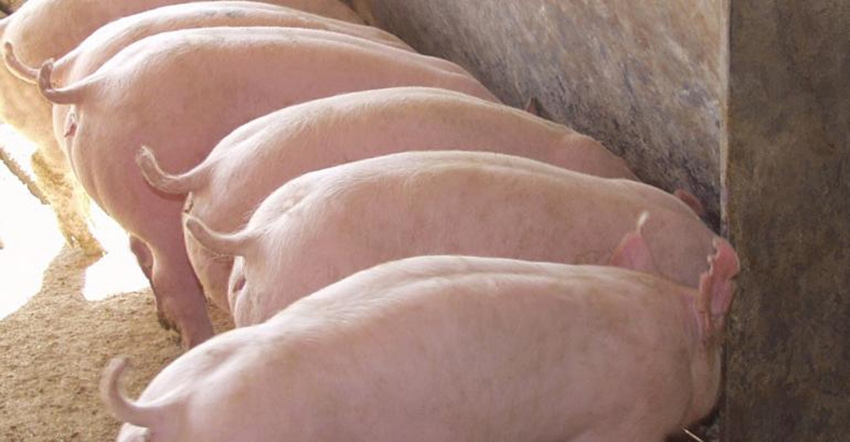Although it may be rare, producers may need to manage on hand feed in the case of FAD or feed mill and packing plant shutdowns.
March 7, 2023

The U.S. swine industry is highly integrated and thus vulnerable to several supply chain disruptions. Beyond COVID-19 related disruptions in 2020, the threat of feed mill and packing plant shutdowns from fire or cyber-attack, or the threat of entry of a foreign animal disease to the United States, may require strategies to extend on-site feeds to group-housed finishing pigs.
In the case of FADs, under the USDA African Swine Fever Response Plan, within a certain impacted radius of a detected ASF outbreak, state veterinarians have the authority issue a National Movement Standstill. This policy will halt commercial truck movement, including live marketing and feed delivery, between facilities for at least 72 hours. This policy comes with many unknowns as well as case-by-case scenarios that producers, field staff and veterinarians will have to work through to ensure proper care of their animals.
One challenge that producers may face is the inability to receive new feed deliveries, forcing them to manage what feed is on-site for an unforeseen amount of time. Therefore, it is important for pig producers to have a plan to hold out pigs while still providing the necessities needed to support pigs in such events.
The objective of this study was to investigate both feed and feeder management strategies producers may be able to utilize to conserve growth performance and maintain adequate carcass composition, and to further assess aggressive behavior corresponding to each strategy of group-housed late finishing pigs under commercial research settings. To assess this objective, approximately 1,400 mixed-sex late finishing pigs were randomly allocated to one of five treatments across 60 pens (22-24 pigs/trt, n=12 pens/trt).
Management strategies investigated included:
Feeding pigs ad libitum, ~3x maintenance requirement for metabolizable energy (MEm), with no restriction (Control)
Pens fed the control diet at 2x their ME maintenance requirement daily (2x MEm)
Pens fed the control diet at 1.45x their ME maintenance requirement daily (1.45x MEm)
Tightening feeders to their lowest setting, provided ad libitum of the control diet (Closed feeders)
Pens fed a whole corn kernel diet, ad libitum (Whole corn)
Maintenance was calculated using the NRC (2012) equation: ME maintenance kcal/d = 197 kcal/kg BW0.6. The diet fed to treatments 1 – 4 was formulated to be representative of a typical commercial corn-soybean meal-based ration and formulated to meet the nutritional requirements for late finishing pigs, while the fifth treatment was given non-ground whole yellow dent corn kernels. Management strategies investigated were in place for 14 days during the restriction period (P1) and thereafter all pens were switched back to the control diet fed ad libitum and measured for seven days (P2) to assess the reintroduction to full feed and fed ad libitum through marketing.
After the first 14 days, it was evident management strategies can effectively be implemented to control daily feed intake and extend on hand feed budgets (Table 1). As a consequence, growth rates were slowed in these market sized pigs (Table 1).
All four strategies investigated reduced average daily gain by 34 – 98%. By design and as a result of the reduced daily feed offered per pen, which when compared to ad libitum, average daily feed intakes were reduced by 22 – 56% after 14 days in P1, with the most severe reductions in performance coming from the 1.45x and 2x MEm treatment groups. After all pens returned to full feed access (P2), all four strategies investigated increased feed intake from 5 – 8% and daily gain 24 – 46%, indicating some compensatory gain and replenishment of gut fill and lean tissue gain. Overall and as expected across the 21-day study, growth performance was reduced when implementing management strategies to limit feed intake.
While these results show that limiting feed intake in group penned pigs is attainable in a commercial setting, one must be cognizant of animal welfare and wellbeing when restricting late finishing pig's feed consumption. Therefore, indicators of aggressive behavior were measured periodically and presented as a percentage of pigs showing total markings due to these behaviors of pen mates, as shown in Figure 1.
Indicators recorded included scratches, side bites, ear bites and sores. Looking at the two strategies to restrict feed intake, both 1.45x and 2x MEm strategy groups had a greater percentage of pigs presented with total abrasions, and by day 14 of the study, just over 40% of the pigs in each pen exhibited marks from aggressive behavior in some facet. Pens fed whole corn kernels or where feeders were tightened did not have as severe abrasions (20 – 25% pigs per pen), however still significantly more total abrasions than the control pens.
When all pens returned to full feed, by day 21, there were no signs of new abrasions, indicating the aggressive behavior observed during the restriction period came to a halt once returned to full feed access. It is important to be noted that minimal mortalities or removals were reported and there was no associated with any of the feeding strategies investigated. Further, if any of these feed management strategies were to be used, pig welfare and wellbeing must be accounted for and prioritized.
Altogether, although it may be rare, producers may need to manage on hand feed in the case of FAD or feed mill and packing plant shutdowns. In cases where feed availability may be limited, these data provides preemptive solutions that come be adopted with marginal impacts to performance and wellbeing of late finishing pigs. However, these strategies will need to be evaluated prior to implementation, as the best solution will come on a case-by-case scenario. This work was supported by the Iowa Pork Industry Center at Iowa State University and United Animal Health (Sheridan, Iowa). For full details of the study, refer to a paper in Translational Animal Science.
You May Also Like



